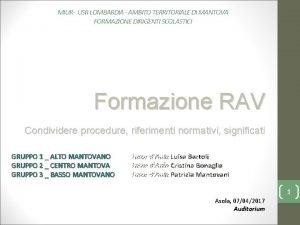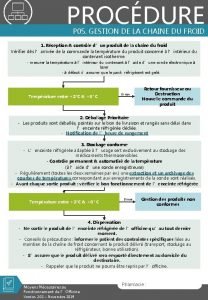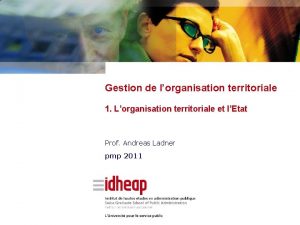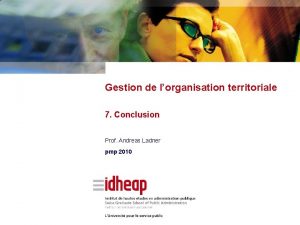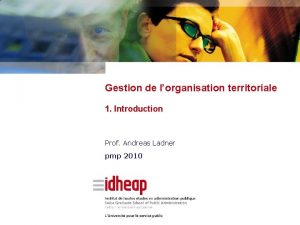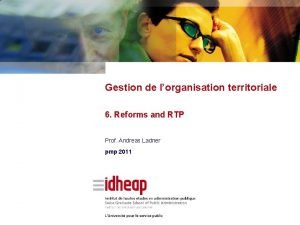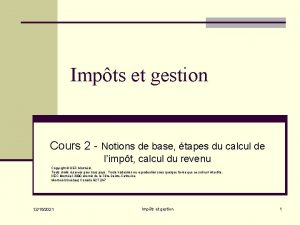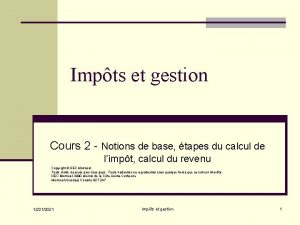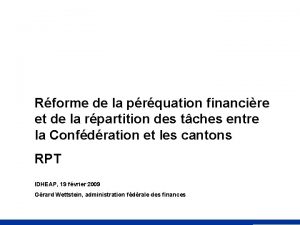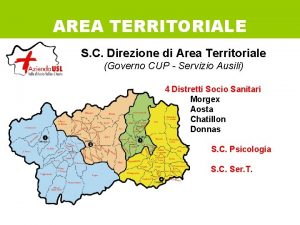Gestion de lorganisation territoriale Impts et prquation Prof





















- Slides: 21

Gestion de l’organisation territoriale Impôts et péréquation Prof. Andreas Ladner pmp 2011

C: Impôts et péréquations financières § Qui décide, qui encaisse quelle sorte d’impôts? § Système de péréquation? | ©IDHEAP - NOM@idheap. unil. ch | | 01/01/2022 |

Competition § Many economist argue that a federation should minimize the extent to which constituent units use tax competition to influence companies and individuals to locate in a particular area (limited control over mobile taxpayers). Danger: downward spiral of tax rates, loss of revenues, focus on other taxes. § Some economist favour fairly extensive tax competition because they believe it can promote better services (Anderson 2008: 31). | ©IDHEAP - NOM@idheap. unil. ch | | 01/01/2022 |

Other considerations § Accountability: Governments are more accountable to their electors when they have to raise most of their revenues. § Equity considerations: Should poorer constituent units have greater tax efforts, lower services or transfer to assist them? § Administrative: Central revenue collection is more advantageous. | ©IDHEAP - NOM@idheap. unil. ch | | 01/01/2022 |

§ http: //www. efd. admin. ch/dokumentation/medieninformation en/00467/index. html? lang=de&msg-id=34001 § http: //www. helvetia. ch/steuerrechner | ©IDHEAP - NOM@idheap. unil. ch | | 01/01/2022 |

Tax systems § Income tax and value added tax § Which shares go to the different tiers? § Who decides on the tax rate? | ©IDHEAP - NOM@idheap. unil. ch | | 01/01/2022 |

Steuersysteme Nach Stalder 1999 | ©IDHEAP - NOM@idheap. unil. ch | | 01/01/2022 |

Einkommenssteuer Schweiz Kanada USA Deutschland Österreich Einziehende Stelle Bund, Kantone, Gemeinden Bund, Provinzen Bund, Staaten Anteil Bund Anteil Gliedstaaten Anteil lokale Ebene 28. 8 63. 0 81. 5 42. 5 69. 0 ca. 43 37. 0 18. 5 42. 5 16. 5 ca. 28 15. 0 14. 5 Steuerföderalis- Bund regelt Steuerföderalis- harmonisiert mus Steuerbasis und mus (Verteil. Progression, schlüssel) über die Höhe entscheiden Provinzen Einkommenssteuer (Lohnsteuer) Steuerverbund (Gemeinschaftssteuer) Nach Stalder 1999, eigene Ergänzungen | ©IDHEAP - NOM@idheap. unil. ch | | 01/01/2022 | Bund

Warenumsatzsteuer Schweiz Kanada USA Deutschland Österreich Wahrenumsatzsteuer Anteil Bund Anteil Gliedstaaten Anteil lokale Ebene 100. 0 46. 2 50. 0 69. 5 100. 0 48. 0 18. 7 Spezialsteuern Weitere Umsatzsteuern 2. 0 11. 8 53. 8 Verteilung Verteilschlüssel Nach Stalder 1999, eigene Ergänzungen | ©IDHEAP - NOM@idheap. unil. ch | | 01/01/2022 |

Taxes in the System of National Accounts (SNA): Percentage of GDP: Total tax receipts National Accounts at a Glance 2010 - ISSN - © OECD 2010 | ©IDHEAP - NOM@idheap. unil. ch | | 01/01/2022 |

The SNA describes three categories of taxes. Here are the two most important ones: § The first category, taxes on production and imports, historically referred to as indirect taxes, is broken down into two components in the SNA: taxes on products, such as VAT, and other taxes on production such as taxes on the ownership or use of land, buildings or other assets used in production or on labour employed (payroll tax). § The second category, current taxes on income, wealth, etc. , consists mainly of taxes levied on the incomes of households and corporations. The category is not described simply as “current taxes on income and wealth” because it includes periodic taxes on households that are assessed neither on the income nor the wealth of the household or its members, for example, poll taxes. | ©IDHEAP - NOM@idheap. unil. ch | | 01/01/2022 |

Taxes in the System of National Accounts (SNA): Percentage of GDP: Taxes on production and imports and Current taxes on income, wealth, etc. National Accounts at a Glance 2010 - ISSN - © OECD 2010 | ©IDHEAP - NOM@idheap. unil. ch | | 01/01/2022 |

| ©IDHEAP - NOM@idheap. unil. ch | | 01/01/2022 |

Social contributions are actual or imputed payments to social insurance schemes to make provision for social insurance benefits. They may be made by employers on behalf of their employees or by employees, selfemployed or non-employed persons on their own behalf. The contributions may be compulsory or voluntary and the schemes may be funded or unfunded. Compulsory social security contributions paid to general government or to social security funds under the effective control of government form an important part of government revenue and, although they are not treated so in the SNA, many analysts (including the OECD’s Tax Directorate) consider the payments as being analogous to a tax on income and so part of a country’s overall tax burden. | ©IDHEAP - NOM@idheap. unil. ch | | 01/01/2022 |

| ©IDHEAP - NOM@idheap. unil. ch | | 01/01/2022 |

Federalist and unitary countries compared | ©IDHEAP - NOM@idheap. unil. ch | | 01/01/2022 |

What about equalization? | ©IDHEAP - NOM@idheap. unil. ch | | 01/01/2022 |

Disparities between constituent units § The wealth of constituent units within federation differs greatly, affecting their ability to raise own-source revenue. § Most federations have provisions for dealing with these differences through transfers. § There is a great variety in the design and the underlying principles for these transfers. | ©IDHEAP - NOM@idheap. unil. ch | | 01/01/2022 |

Transfers to constituent units § In all countries central government raises more revenue than it spends for its own needs. § Some transfers are unconditional, others are conditional (and for example promote the achievement of national purposes or standards). | ©IDHEAP - NOM@idheap. unil. ch | | 01/01/2022 |

Central transfer relative to constituent-unit spending | ©IDHEAP - NOM@idheap. unil. ch | | 01/01/2022 |

Different redistribution systems § Usually there are transfers from central government to the constituent units. In Switzerland Germany there also transfers from richer to poorer constituent units. § What is the aim of the equalization: minimal standards, same level, within a range, super-equalization? § The importance of unconditional transfers in equalization programs varies. § Conditional transfers can also include equalization considerations. § Central government spending (investments) in specific areas can also have a equalizing effect. | ©IDHEAP - NOM@idheap. unil. ch | | 01/01/2022 |
 Https://gestion.parcoursup.fr/gestion/authentification
Https://gestion.parcoursup.fr/gestion/authentification Ufficio scolastico provinciale modena
Ufficio scolastico provinciale modena Kommando territoriale aufgaben der bundeswehr
Kommando territoriale aufgaben der bundeswehr Ufficio scolastico regionale varese
Ufficio scolastico regionale varese Pianificazione territoriale
Pianificazione territoriale Marketing territoriale
Marketing territoriale Ufficio scolastico regionale venezia
Ufficio scolastico regionale venezia Marketing territoriale riassunto
Marketing territoriale riassunto Obiettivi pei per aree
Obiettivi pei per aree Ufficio scolastico verona
Ufficio scolastico verona Settore terziario in spagna doc
Settore terziario in spagna doc Animation territoriale
Animation territoriale Sistema de gestión de seguridad operacional
Sistema de gestión de seguridad operacional Pei guatemala
Pei guatemala Mas salud jujuy
Mas salud jujuy Gestion valor ganado
Gestion valor ganado Gestion de la chaine de froid
Gestion de la chaine de froid Especialización en gestión ambiental sena
Especialización en gestión ambiental sena Dialogue de gestion eple
Dialogue de gestion eple Signet en ligne
Signet en ligne Gestion de tiempo
Gestion de tiempo Gestion de actuaciones policiales gap
Gestion de actuaciones policiales gap








